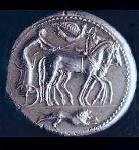

Map of Sicily showing the towns discussed
Click on the images to see larger versions

Obverse

Reverse
Images courtesy of the Dartmouth College Department of Classics.
Syracusan Coinage under Gelon and Hieron I:
A Reconsideration of the Demareteion Dekadrachms
by Nathaniel Fick
Nineteenth-century French scholar François Lenormant captured the essence of classical numismatics when he wrote, "Greek coins are like so many fragments taken from the Parthenon frieze." 1. More than mere currency, the coins of the Greeks reflect their highest artistic achievements while simultaneously serving as a medium for the dissemination of news and information. Nowhere are these functions more evident than in the stunning fifth-century silver issues of Sicilian Syracuse.
In this paper, I intend to examine the coinage issued from Gelon's relocation to Syracuse from Gela in 485 bc, to the tumultuous years following the death of Hieron I in 466 bc, with particular emphasis on the chronology and significance of the dekadrachms attributed to the Demareteion Master. A critical examination of literary sources and recent scholarship, including hoard evidence and die studies, suggests that a reappraisal of their dating and purpose is needed.
First, I wish to objectively describe the coins as material objects, without regard to interpretation. They are dekadrachms, having a value equivalent to ten Attic drachms, a diameter of 35 millimeters, and an average weight of approximately 43 grams, in keeping with the then-prevalent Attic weight standard of 4.3 grams to one drachm. The obverse depicts a slow quadriga driven to the right by a male charioteer wearing a long chiton; Nike, holding a crown, is flying above to the right; below, a rampant lion faces right. The reverse showcases the profile head of Arethusa facing right within a nimbus with four dolphins around (the whole type representing the fresh-water spring on the island of Ortygia and the sea surrounding it); she wears an olive wreath, and her hair is waved and dressed in a krobylos, with a long, curving lock extending down behind the ear; the legend ![]() surrounds her. The series was struck using three obverse and five reverse dies. Of the original issue, eighteen specimens are currently extant, with the finest known example residing in the Museum of Fine Arts in Boston. 2.
surrounds her. The series was struck using three obverse and five reverse dies. Of the original issue, eighteen specimens are currently extant, with the finest known example residing in the Museum of Fine Arts in Boston. 2.
Starting before, and extending long after, the production of the Demareteion dekadrachms, Syracuse issued a massive series of silver tetradrachms. They average 17.2 grams in weight, and measure 26-27 millimeters in diameter. Their devices are similar to those of their larger counterparts, although their dates of issue cover a much wider period and therefore reflect a broader view of the evolution of Greek numismatic art. From their first striking as the new imperial coinage shortly after the accession of Gelon in 485, until their disappearance around 425, the Syracusan tetradrachms present a "veritable procession of korai," slowly evolving into splendid examples of the high Classical style. 3. It is within the framework of these coins that the Demareteion dekadrachms must be evaluated.
Traditional scholarship (Hill, Evans, Sear, et al) labels the dekadrachms as commemoratives of Gelon's crushing defeat of the Carthaginians at Himera in 480 bc. This attribution rests on the following passage from Diodorus:
The Carthaginians, having unexpectedly gained their deliverance, not only agreed [to Gelon's terms] but also promised to give in addition a gold crown to Demarete, the wife of Gelon. For Demarete at their request had contributed the greatest aid toward the conclusion of the peace, and when she had received the crown of one hundred gold talents from them, she struck a coin which was called from her a Demareteion. This was worth ten Attic drachmas and was called by the Sicilian Greeks, according to its weight, a pentekontalitron.4.
Easily accepted at first glance, as the Duc de Luynes did in 1831, thus initiating a century and a half of misinterpretation, further analysis of the passage uncovers its fallibility. 5. Combined with other sources of information, the association of the first dekadrachms of Syracuse with the battle of Himera's aftermath becomes suspect.
Diodorus wrote nearly five centuries after the time of Gelon. While certainly drawing on earlier writers whose works have not survived, his story must not be viewed as contemporary with the coins in question. Ignoring the independent numismatic evidence for a moment, I wish to take Diodorus' literary claim to its logical extensions, and then compare them with the evidence at hand.
The most obvious quandary is that while Demarete received a gold crown from Carthage, the coins were struck in silver. Diodorus seems to mean that the coins were gold, and a reader not familiar with Attic coinage (and the fact that drachms are invariably silver) would accept that logical implication. British numismatist Colin Kraay subscribes to this literal interpretation of the text, and suggests that "gold coins of the value of 10 drachmae or 50 litrae would be perfectly reasonable." 6. Additionally, he argues, coins known to be named after people are all gold: the Persian Daric, Macedonian Philip, and Lydian Croeseid, among others. This is an interesting, though perhaps irrelevant, observation. Silver pieces tend to be known by their designs: the "turtles" of Aegina, "owls" of Athens, and "bees" of Ephesos. Assuming for a moment that Kraay is correct and that the Demareteion is a gold coin, we are left to explain why none are known to exist. The earliest confirmed Syracusan gold pieces date from the time of Dionysius, nearly three quarters of a century later, and are of sufficiently Classical style to preclude an attribution to Gelon. Despite the small size of gold coins (and the related likelihood of being lost), their increased propensity to be melted for other purposes, and the unpredictable vagaries of twenty four intervening centuries, I cannot accept that the entire series would vanish without a trace. On the other hand, it is plausible that Diodorus incorporated an earlier telling of the story and left out the conversion of the gold crown into silver bullion in the state treasury.
Translating this conversion into an actual number of coins struck is a somewhat speculative exercise. Evans made the most valiant attempt, and I rely on his calculations. 7. Assuming the hundred talents to be on the Attic standard, and so equivalent to six gold drachmae, yields a projected mintage of 780 Demareteioi. Taking the crown to be 100 Sicilian talents, worth 120 gold litrae apiece, furnishes a sum of 3120 pentekontalitra -- a number which Evans found much more reasonable for a such a legendary issue in numismatic history. The former figure, however, more nearly equates to the widely-accepted "3% Rule" of numismatists, which postulates that an average of three percent of mintage totals survives from antiquity. Applying this generalization to 780 yields a projected current existence of 23 coins, quite close to the 18 actually known, and safely allowing for the nearly-inevitable discovery of a few more. It is probable that the Syracusans originally measured the value of their gift in Sicilian talents. Whether Diodorus accounted for this or assumed the Attic standard (which seems likely given his reference to the Athenian drachm) is a matter of debate; either way, another element of uncertainty is ascribed to the text. The essential point here, regardless of which standard is correct, is that the entire mintage of dekadrachms was rather small, certainly not a large percentage of Syracusan coinage production.
The main currency of fifth-century Syracuse was the tetradrachm. Much of its chronology is directly dependent on the dating and interpretation of the Demareteion dekadrachms, and this introduces another argument against the latter coins being commemoratives issued shortly after the battle of Himera in 479. A relatively static design, changing only with the slow tide of art instead of annual whim, allows individual coins to be accurately placed within a chronology even when actual dates are disputable. The Demareteion type incorporates a rather long evolution of the stock Syracusan designs: the horses lean forward in a show of motion not found in the earlier archaic pieces, but they still lack the energy of later tetradrachms; the hair of Arethusa is not entirely composed of geometric patterns, but lacks the flowing locks of later coins; her eye is still frontal. Perhaps most important of all, the tetradrachms of the archaic period have nothing in the obverse exergue, while those of more classical design picture a sea monster and, later, a dolphin. It is tempting to place the Demareteion issues into the transitional period between these two major types, and it seems stylistically reasonable to do so.8.
Having established a basic chronology with which to work, the trouble of the traditional dating system emerges. Assuming that the dekadrachms come later than their counterparts with empty exergues, that the archaic pieces were first struck upon the accession of Gelon at Syracuse, and that they are indeed commemorative of the Carthaginian defeat at Himera, it is necessary to cram the entire archaic series into only seven years (485 to 479). This is absurd. Clearly, one or more of the above premises must be false. Stylistic scrutiny supports the verity of the first, and the second is sustained by hoard evidence (namely the 1956 Gela hoard -- see note 9), thus exposing the third to attack. 9.
Accepting 479 as the terminus ante quem for the early tetradrachms means that we must reconcile the use of 142 obverse dies in 7 years -- an average of 20 new dies annually. The question of die lifespan has been a topic of much debate in numismatic circles, but a general consensus seems to indicate that 10,000 coins per die is not an unreasonable estimate; hence, nearly 1.5 million tetradrachms in this period. This would require 1000 talents of silver, or 25 tons. The physical effort required to produce so many coins is large, but not so great as to present a logistical impasse for a city as populous and advanced as Syracuse under Gelon. Nor is it particularly difficult to imagine the consumption of so many dies in that time period. The limiting agent is the availability of silver. 10.
Kraay produces two definitive comparisons which effectively negate the possibility that Syracuse produced these 142 dies in only 7 years: contemporary Athens, and Syracuse for the rest of the fifth century (from 479 to 400). 11. During the period from 510 to 480, Athens is supposed to have produced between 500 and 600 dies, for an average of 20 per year, similar to that of Syracuse in the era being examined. By 483, Athens had laid up a reserve of 100 talents, used by Themistocles to build the great Athenian navy which defeated Persia at Salamis. By comparison, the Syracusans are said to have amassed ten times that amount -- an astounding 1000 talents. Given the rich Laurion mines which Athens had at her disposal, as opposed to the total absence of native silver anywhere in Sicily, it is difficult to believe that these figures are correct. Likewise, the assertion of 142 dies does not hold up to comparison with later Syracuse. From 479 to 400, only 111 tetradrachm dies are recorded -- 31 fewer than those in the traditional seven-year period before the dekadrachms. 12. A problem related to this view is the five-year hiatus it imposes on Syracusan coinage production.